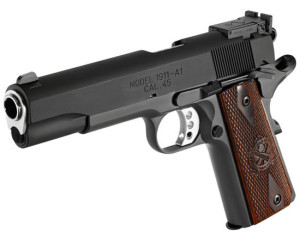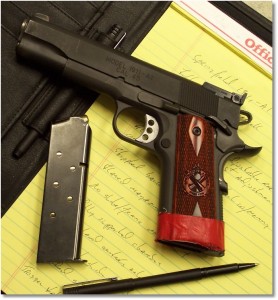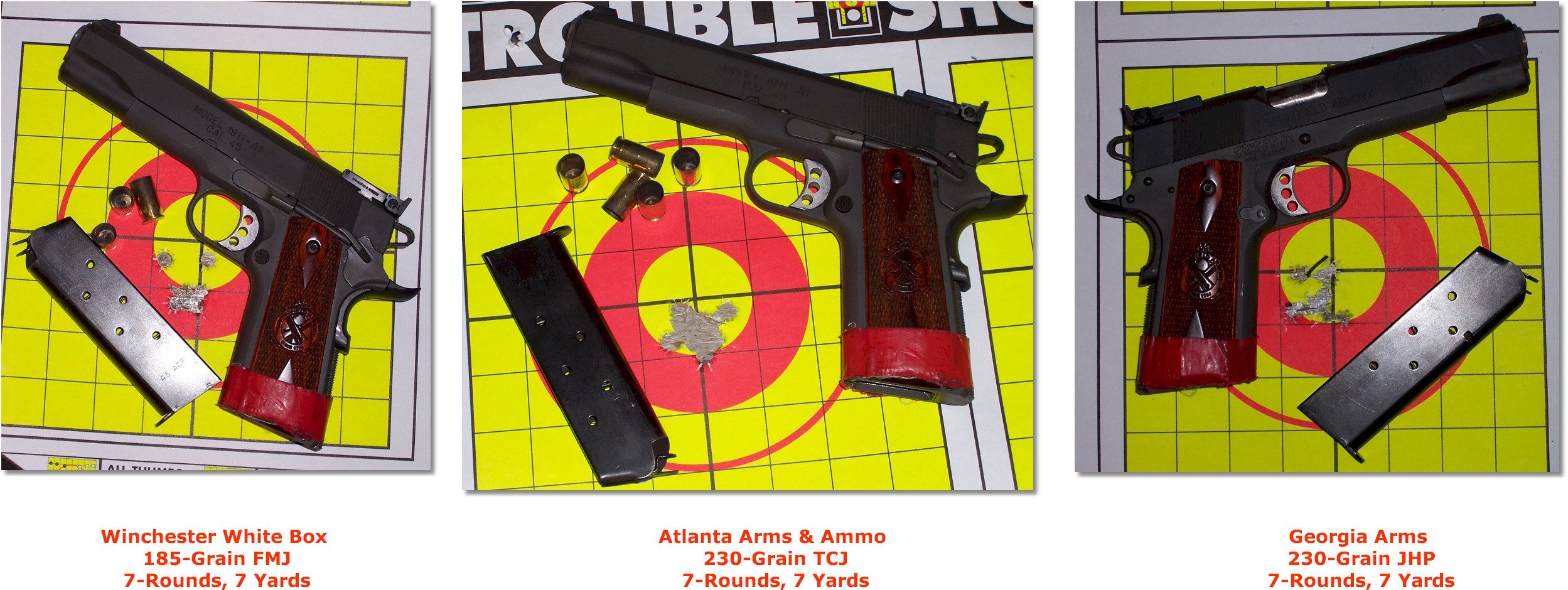So you looking to rid yourself of unwanted pest, are you? Or, perhaps you want to win a local IDPA event. Well, both take the right tools.
There is a product on the market that allows you to rid yourself of unwanted pests without the mixing of chemicals (pre-mixing is provided), no shaking of a can, is capable of pinpoint accuracy, and comes in its own container. That product is the .45 acp round and when housed in the Springfield 1911 A1 Range Officer, you will have no problems ridding yourself of unwanted pests that attempt to attack your person or invade your home with the intent of doing mass destruction.
When you want to complete in bulls-eye, IPSC, or IDPA matches, the Springfield 1911 A1 Range Officer will help you out in those areas as well.
The Springfield 1911 A1 Range Officer is much more than your Garandpa’s (pun intended) military 45. The Springfield 1911 A1 Range Officer is a fine example of what simple modifications can do for handgun excellence.
In my test gun, a range gun (note the red tape around the grip) that I acquired for the test, the fit of the slide to the frame is impeccable with nary a detectable movement while in battery. The Springfield 1911 A1 Range Officer incorporates the G.I. style guide rod and plug; some say that is a welcome return to the past. The 5″ match-grade barrel says accuracy with a long sight radius for you to peer down.
The Parkerized finish, seemingly, holds up well; many have used and abused this gun.
The front sight is fixed while the Bowmar rear sight is adjustable for both elevation and windage both, of which, are easily adjustable with large adjustment screws. Neither the front or rear sight contain dots, dashes, our outlines (the range gun had a painted front sight that did nothing for me). Some say an adjustable rear sight is great for competition but not so great for defense. If need be, the sights can be changed for a more suitable sight for defense.
The well-serrated slide makes for an easy load check or for pulling the slide to the rear.
Springfield pistols sold after January 2001 have a loaded chamber indicator. The barrel slot allows you to observe whether a shell is in the chamber and you can clearly see the brass case of a chambered round. All models but the G.I. model has this feature.
The frame features a checkered polymer main spring housing, plain front strap, checkered Cocobolo grips, a lightweight speed trigger, extended thumb safety, high rise beavertail grip safety, and skeletonized hammer. A nicely crosscut set of panels adorn the grip area and contain the double-diamond pattern along with the Springfield logo.
All controls are set up for a right-handed shooter, I found all controls well within reach of my various digits with the extended safety (in my opinion) being a plus. The slide stop lever was easy to actuate with the thumb of my shooting hand, the thumb of my support hand (left), or the index finger of the left hand when shooting left-handed.
The extended safety worked well and easy using the thumb of the shooting hand (right-handed) or the trigger finger of the left hand (left-handed shooting)
The magazine release button pushes in easily with the thumb of my shooting hand or the middle finger of the left hand. The gun comes with two 7-round magazines that slide into a beveled magazine well. The all-steel magazines load easily and without the use of an aid and drop freely from the magazine when you push the magazine release button.
The magazine, when loaded, positions the first round slightly low of center in the bore, as indicated by the “feed marks” in the chamber mouth.
The nicely textured rear of the grip frame allows for a positive hold while the beavertail safety, with its memory bump, provides a positive push on the grip safety. The extended beavertail keeps unwanted hand parts away from the skeletonized hammer.
The rear of the grip frame incorporates an “Integral Locking System” (ILS) that allows you to lock or unlock the pistol when in storage. Springfield provides a small key for this purpose. In addition, a small hole to the right of the ILS provides access for removing the mainspring housing. Springfield provides a small Allen-key for this purpose.
Notice from the Manufacturer: The slide of a 1911-A1 pistol should never be released on an empty chamber; especially one which has had an action job. Releasing the slide on an empty chamber causes damage to the breech face on the barrel and undue stress on all action parts, including the hammer and the sear. This will ruin the action job performed on your pistol.
I saved the trigger group for last, as this was a very positive feature for me. Your finger will travel about 0.040″ before encountering resistance. From that point, a 4.8-pound trigger will travel a very short distance until releasing with little to no over-travel. The trigger breaks as crisp as a cold winter’s morning when you walk out the door. If there was any give, it was in the pad of my trigger finger. The trigger on the Springfield 1911 A1 Range Officer is a joy to press.
Range Time:
As my usual, I set the target at 7 yards and really felt guilty about doing so, as this gun screams “competition” and I was really going to under-whelm it by shooting at a combat distance. I had a feeling about this gun and chose the “Troubleshooter” target that consisted of four individual targets. Usually, and on a gun that I am unfamiliar with, I go for a slightly larger target and fire three test shots for accuracy and sight placement. For some reason, I did not do that with this gun. I was hoping that I was right about the accuracy of the gun, as I had read several very positive reports about the “Range Officer”.
I planned shooting this gun unsupported, two-handed, and slow fired and I had three different types of ammunition available to me:
- Winchester White Box 185-grain FMJ
- Atlanta Arms & Ammo 230-grain TCJ
- Georgia Arms 230-grain JHP
Even though the particular gun that I was shooting was a range gun, I set the sights for a “covered” sight picture, unbeknown if the previous shooter had set the sights to his/her preference.
The Winchester White Box 185-grain FMJ was to be the first rounds through the gun. Squeezing off the first shot, I saw a hole appear in the target just below the “X” and almost perfectly centered. I pulled off the second shot and saw the impact left of center. Just to see if it was the gun or me, I shot the next five rounds with the sights on the bottom of the center ring. I could put a finger through the singular hole that they made. This is an extremely accurate gun.
Moving on to the Atlanta Arms & Ammo range loads (230-grain TCJ) produced a single, small hole just below the “X” with the sights set as close to dead-center as I could place them.
The results of 7-rounds of Georgia Arms 230-grain JHP produced almost identical results as the Atlanta Arms & Ammo range loads.
After the initial testing, I started playing with some double-taps. The ease of which the Range Officer comes back on target is very impressive to say the least. Also, simply pick a point on the target in which you want a hole to appear, click and voila! A hole appears!
Summary:
I can honestly say that I have had a couple of big-name 1911s that did not shoot nearly as accurately as the Range Officer does. Finding a fair-priced 1911-style pistol with quality parts, is 100% reliable, and is more accurate than I can be with it makes me want to work on owning it one day!
The intended purpose of the Range Officer is that of a 1911 ready for competition. With that said, I believe it is equally well suited as a carry gun for self-defense, survival, law enforcement duty, or anything else you can think of.
For concealed carry, and in my opinion, the two things going against it is weight and size. This is a full-size pistol. The weight and size help decrease felt recoil but goes against the grain of thought for a light, compact concealed carry handgun. However, there are many who can and do carry “duty” size pistols and are able to conceal them fully.
It seems that I have been firing more 1911-style pistols these days and, like the attraction of a magnet to steel, I am considering carrying one for defensive purposes again. A Mil-Spec or Loaded model is garnering my attention.
For additional information about the Springfield Range Officer, go to: http://www.springfield-armory.com/products/1911-range-officer-45-acp/
![]()




